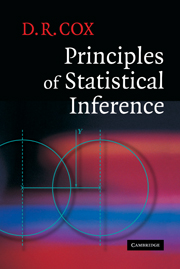Book contents
- Frontmatter
- Contents
- List of examples
- Preface
- 1 Preliminaries
- 2 Some concepts and simple applications
- 3 Significance tests
- 4 More complicated situations
- 5 Interpretations of uncertainty
- 6 Asymptotic theory
- 7 Further aspects of maximum likelihood
- 8 Additional objectives
- 9 Randomization-based analysis
- Appendix A A brief history
- Appendix B A personal view
- References
- Author index
- Subject index
4 - More complicated situations
Published online by Cambridge University Press: 17 March 2011
- Frontmatter
- Contents
- List of examples
- Preface
- 1 Preliminaries
- 2 Some concepts and simple applications
- 3 Significance tests
- 4 More complicated situations
- 5 Interpretations of uncertainty
- 6 Asymptotic theory
- 7 Further aspects of maximum likelihood
- 8 Additional objectives
- 9 Randomization-based analysis
- Appendix A A brief history
- Appendix B A personal view
- References
- Author index
- Subject index
Summary
Summary. This chapter continues the comparative discussion of frequentist and Bayesian arguments by examining rather more complicated situations. In particular several versions of the two-by-two contingency table are compared and further developments indicated. More complicated Bayesian problems are discussed.
General remarks
The previous frequentist discussion in especially Chapter 3 yields a theoretical approach which is limited in two senses. It is restricted to problems with no nuisance parameters or ones in which elimination of nuisance parameters is straightforward. An important step in generalizing the discussion is to extend the notion of a Fisherian reduction. Then we turn to a more systematic discussion of the role of nuisance parameters.
By comparison, as noted previously in Section 1.5, a great formal advantage of the Bayesian formulation is that, once the formulation is accepted, all subsequent problems are computational and the simplifications consequent on sufficiency serve only to ease calculations.
General Bayesian formulation
The argument outlined in Section 1.5 for inference about the mean of a normal distribution can be generalized as follows. Consider the model fY|Θ(y | θ), where, because we are going to treat the unknown parameter as a random variable, we now regard the model for the data-generating process as a conditional density. Suppose that Θ has the prior density fΘ(θ), specifying the marginal distribution of the parameter, i.e., in effect the distribution Θ has when the observations y are not available.
Information
- Type
- Chapter
- Information
- Principles of Statistical Inference , pp. 45 - 63Publisher: Cambridge University PressPrint publication year: 2006
